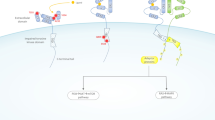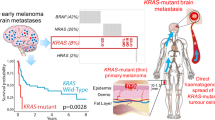Abstract
Tyrosine phosphorylation is important in signaling pathways underlying tumorigenesis. We performed a mutational analysis of the protein tyrosine kinase (PTK) gene family in cutaneous metastatic melanoma. We identified 30 somatic mutations affecting the kinase domains of 19 PTKs and subsequently evaluated the entire coding regions of the genes encoding these 19 PTKs for somatic mutations in 79 melanoma samples. We found ERBB4 mutations in 19% of individuals with melanoma and found mutations in two other kinases (FLT1 and PTK2B) in 10% of individuals with melanomas. We examined seven missense mutations in the most commonly altered PTK gene, ERBB4, and found that they resulted in increased kinase activity and transformation ability. Melanoma cells expressing mutant ERBB4 had reduced cell growth after shRNA-mediated knockdown of ERBB4 or treatment with the ERBB inhibitor lapatinib. These studies could lead to personalized therapeutics specifically targeting the kinases that are mutationally altered in individual melanomas.
This is a preview of subscription content, access via your institution
Access options
Subscribe to this journal
Receive 12 print issues and online access
$209.00 per year
only $17.42 per issue
Buy this article
- Purchase on Springer Link
- Instant access to full article PDF
Prices may be subject to local taxes which are calculated during checkout





Similar content being viewed by others
Accession codes
Accessions
NCBI Reference Sequence
References
Jemal, A. et al. Cancer Statistics, 2006. CA Cancer J. Clin. 56, 106–130 (2006).
Tsao, H., Atkins, M.B. & Sober, A.J. Management of cutaneous melanoma. N. Engl. J. Med. 351, 998–1012 (2004).
Futreal, P.A. et al. A census of human cancer genes. Nat. Rev. Cancer 4, 177–183 (2004).
Sawyers, C. Targeted cancer therapy. Nature 432, 294–297 (2004).
Sjöblom, T. et al. The consensus coding sequences of human breast and colorectal cancers. Science 314, 268–274 (2006).
Greenman, C. et al. Patterns of somatic mutation in human cancer genomes. Nature 446, 153–158 (2007).
Godin-Heymann, N. et al. Oncogenic activity of epidermal growth factor receptor kinase mutant alleles is enhanced by the T790M drug resistance mutation. Cancer Res. 67, 7319–7326 (2007).
Soung, Y.H. et al. Somatic mutations of the ERBB4 kinase domain in human cancers. Int. J. Cancer 118, 1426–1429 (2006).
Ding, L. et al. Somatic mutations affect key pathways in lung adenocarcinoma. Nature 455, 1069–1075 (2008).
Bouyain, S., Longo, P.A., Li, S., Ferguson, K.M. & Leahy, D.J. The extracellular region of ErbB4 adopts a tethered conformation in the absence of ligand. Proc. Natl. Acad. Sci. USA 102, 15024–15029 (2005).
Qiu, C. et al. Mechanism of activation and inhibition of the HER4/ErbB4 kinase. Structure 16, 460–467 (2008).
Riese, D.J. II, Gallo, R.M. & Settleman, J. Mutational activation of ErbB family receptor tyrosine kinases: insights into mechanisms of signal transduction and tumorigenesis. Bioessays 29, 558–565 (2007).
Frey, M.R., Edelblum, K.L., Mullane, M.T., Liang, D. & Polk, D.B. The ErbB4 growth factor receptor is required for colon epithelial cell survival in the presence of TNF. Gastroenterology 136, 217–226 (2009).
Heymach, J.V., Nilsson, M., Blumenschein, G., Papadimitrakopoulou, V. & Herbst, R. Epidermal growth factor receptor inhibitors in development for the treatment of non-small cell lung cancer. Clin. Cancer Res. 12, 4441s–4445s (2006).
Grant, S., Qiao, L. & Dent, P. Roles of ERBB family receptor tyrosine kinases, and downstream signaling pathways, in the control of cell growth and survival. Front. Biosci. 7, d376–d389 (2002).
Weinstein, I.B. Addiction to oncogenes—the Achilles heal of cancer. Science 297, 63–64 (2002).
McHugh, L.A. et al. Lapatinib, a dual inhibitor of ErbB-1/-2 receptors, enhances effects of combination chemotherapy in bladder cancer cells. Int. J. Oncol. 34, 1155–1163 (2009).
Rusnak, D.W. et al. The effects of the novel, reversible epidermal growth factor receptor/ErbB-2 tyrosine kinase inhibitor, GW2016, on the growth of human normal and tumor-derived cell lines in vitro and in vivo. Mol. Cancer Ther. 1, 85–94 (2001).
Xia, W. et al. Combining lapatinib (GW572016), a small molecule inhibitor of ErbB1 and ErbB2 tyrosine kinases, with therapeutic anti-ErbB2 antibodies enhances apoptosis of ErbB2-overexpressing breast cancer cells. Oncogene 24, 6213–6221 (2005).
Shih, L.Y. et al. Heterogeneous patterns of FLT3 Asp(835) mutations in relapsed de novo acute myeloid leukemia: a comparative analysis of 120 paired diagnostic and relapse bone marrow samples. Clin. Cancer Res. 10, 1326–1332 (2004).
Pao, W. et al. Acquired resistance of lung adenocarcinomas to gefitinib or erlotinib is associated with a second mutation in the EGFR kinase domain. PLoS Med. 2, e73 (2005).
Allen, L.F., Eiseman, I.A., Fry, D.W. & Lenehan, P.F. CI-1033, an irreversible pan-erbB receptor inhibitor and its potential application for the treatment of breast cancer. Semin. Oncol. 30, 65–78 (2003).
Sharma, S.V., Bell, D.W., Settleman, J. & Haber, D.A. Epidermal growth factor receptor mutations in lung cancer. Nat. Rev. Cancer 7, 169–181 (2007).
Palavalli, L.H. et al. Analysis of the matrix metalloproteinase family reveals that MMP8 is often mutated in melanoma. Nat. Genet. 41, 518–520 (2009).
Gordon, D., Abajian, C. & Green, P. Consed: a graphical tool for sequence finishing. Genome Res. 8, 195–202 (1998).
Bhangale, T.R., Stephens, M. & Nickerson, D.A. Automating resequencing-based detection of insertion-deletion polymorphisms. Nat. Genet. 38, 1457–1462 (2006).
Chappell, D.B., Zaks, T.Z., Rosenberg, S.A. & Restifo, N.P. Human melanoma cells do not express Fas (Apo-1/CD95) ligand. Cancer Res. 59, 59–62 (1999).
Samuels, Y. et al. High frequency of mutations of the PIK3CA gene in human cancers. Science 304, 554 (2004).
Solomon, D.A. et al. Mutational inactivation of PTPRD in glioblastoma multiforme and malignant melanoma. Cancer Res. 68, 10300–10306 (2008).
Guex, N. & Peitsch, M.C. SWISS-MODEL and the Swiss-PdbViewer: an environment for comparative protein modeling. Electrophoresis 18, 2714–2723 (1997).
Acknowledgements
We thank B. Vogelstein, T. Waldman, D. Bell, P. Meltzer, L. Brody, G. Merlino, S. Gutkind and I. Cardenas-Navia for their helpful comments on the manuscript; members of the NISC Comparative Sequencing Program for generating the sequence data analyzed here; and S. Anderson and M. Kirby for assistance with FACS analysis. This work supported by the Intramural Research Programs of the National Human Genome Research Institute and National Cancer Institute, National Institutes of Health, USA.
Author information
Authors and Affiliations
Consortia
Contributions
T.D.P. and Y.S. designed the study; J.R.W. and S.A.R. collected and analyzed the melanoma samples; N.S.A., J.C.C., K.E.Y., J.C.L., the NISC Comparative Sequencing Program, P.C. and Y.S. analyzed the genetic data; T.D.P., X.W. and K.E.Y. performed and analyzed the functional data. All authors contributed to the final version of the paper.
Corresponding author
Supplementary information
Supplementary Text and Figures
Supplementary Figures 1–9, Supplementary Tables 1–7 and Supplementary Note (PDF 1365 kb)
Rights and permissions
About this article
Cite this article
Prickett, T., Agrawal, N., Wei, X. et al. Analysis of the tyrosine kinome in melanoma reveals recurrent mutations in ERBB4. Nat Genet 41, 1127–1132 (2009). https://doi.org/10.1038/ng.438
Received:
Accepted:
Published:
Issue Date:
DOI: https://doi.org/10.1038/ng.438
This article is cited by
-
Network pharmacology‑based investigation of potential targets of triptonodiol acting on non-small-cell lung cancer
European Journal of Medical Research (2023)
-
Risk stratification and pathway analysis based on graph neural network and interpretable algorithm
BMC Bioinformatics (2022)
-
Antitumour immunity regulated by aberrant ERBB family signalling
Nature Reviews Cancer (2021)
-
Diverse roles of epidermal growth factors receptors in oral and cutaneous canine melanomas
BMC Veterinary Research (2020)
-
The role of ErbB4 in cancer
Cellular Oncology (2020)



